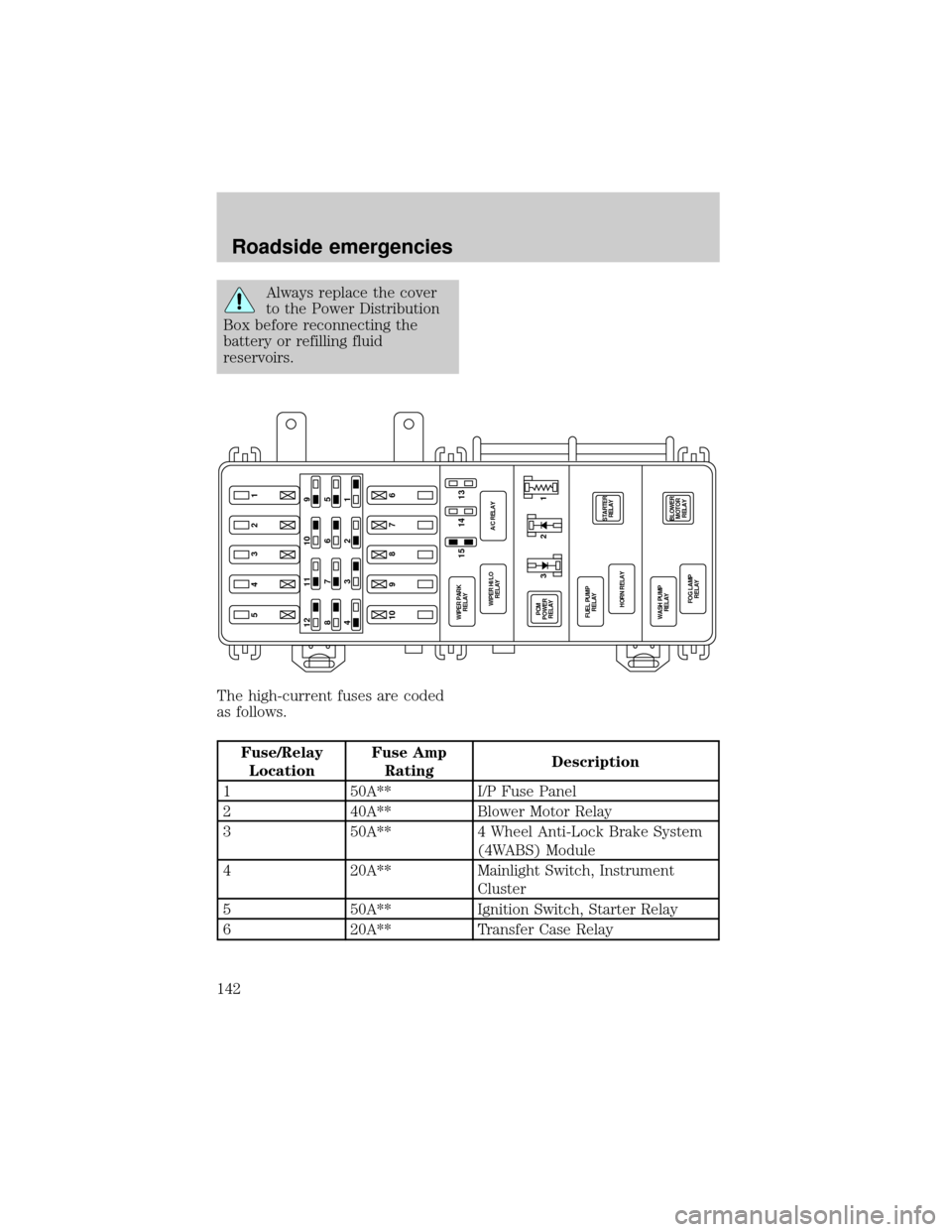Light Mercury Mountaineer 1998 s Owner's Guide
[x] Cancel search | Manufacturer: MERCURY, Model Year: 1998, Model line: Mountaineer, Model: Mercury Mountaineer 1998Pages: 216, PDF Size: 1.72 MB
Page 116 of 216

Once through water, always try the
brakes. Wet brakes do not stop the
vehicle as effectively as dry brakes.
Drying can be improved by moving
your vehicle slowly while applying
light pressure on the brake pedal.
After driving through mud, clean
off residue stuck to rotating
driveshafts and tires. Excess mud
stuck on tires and rotating
driveshafts causes an imbalance
that could damage drive
components.
If the transmission and transfer
case are submerged in water, their
fluids should be checked and
changed, if necessary.
Water intrusion into the
transmission may damage the
transmission.
If the rear axle is submerged in
water, the rear axle lubricant
should be checked and changed, if
necessary. The rear axle is filled
with a synthetic lubricant and does
not normally require a lubricant
change for the life of the vehicle.
Rear axle lubricant quantities
should not need to be checked
unless a leak is suspected.
Driving on hilly or sloping
terrain
When driving on a hill, avoid
driving crosswise or turning on
steep slopes. You could lose
traction and slip sideways. Drive
straight up, straight down or avoid
the hill completely. Know the
conditions on the other side of a
Driving
116
Page 119 of 216

Driving off-road with AWD
Your vehicle is specially equipped
for driving on sand, snow, mud and
rough terrain and has operating
characteristics that are somewhat
different from conventional
vehicles, both on and off the road.
Maintain steering wheel control at
all times, especially in rough
terrain. Since sudden changes in
terrain can result in abrupt
steering wheel motion, make sure
you grip the steering wheel from
the outside. Do not grip the
spokes.
Drive cautiously to avoid vehicle
damage from concealed objects
such as rocks and stumps.
You should either know the terrain
or examine maps of the area
before driving. Map out your route
before driving in the area. For
more information on driving
off-road, read the ªFour Wheelingº
supplement in your owner's
portfolio.
If your vehicle gets stuck
If the vehicle is stuck, shift the
transmission in a steady motion
between forward and reverse
gears. Allow the transmission to
engage, then press lightly on the
accelerator.
Do not rock the vehicle for
more than a few minutes. The
transmission and tires may be
damaged or the engine can
overheat.
Driving
119
Page 120 of 216

Do not spin the wheels at
over 56 km/h (35 mph).
The tires may fail and injure a
passenger or bystander.
Sand
When driving over sand, try to
keep all four wheels on the most
solid area of the trail. Do not
reduce the tire pressures but shift
to a lower gear and drive steadily
through the terrain. Apply the
accelerator slowly and avoid
spinning the wheels.
Mud and water
If you must drive through high
water, drive slowly. Traction or
brake capability may be limited.
When driving through water,
determine the depth; avoid water
higher than the bottom of the hubs
(if possible) and proceed slowly. If
the ignition system gets wet, the
vehicle may stall.
Once through water, always try the
brakes. Wet brakes do not stop the
vehicle as effectively as dry brakes.
Drying can be improved by moving
your vehicle slowly while applying
light pressure on the brake pedal.
After driving through mud, clean
off residue stuck to rotating
driveshafts and tires. Excess mud
stuck on tires and rotating
driveshafts causes an imbalance
that could damage drive
components.
Driving
120
Page 126 of 216

maximum GCWR for your type
engine and rear axle ratio.
3. Weigh your vehicle as you
customarily operate the vehicle
without cargo. To obtain correct
weights, try taking your vehicle to
a shipping company or an
inspection station for trucks.
4. Subtract your loaded vehicle
weight from the maximum GCWR
on the following charts. This is the
maximum trailer weight your
vehicle can tow and must fall
below the maximum shown under
maximum trailer weight on the
chart.
DRIVING THROUGH WATER
Do not drive quickly through
standing water, especially if the
depth is unknown. Traction or
brake capability may be limited
and if the ignition system gets wet,
your engine may stall. Water may
also enter your engine's air intake
and severely damage your engine.
If driving through deep or standing
water is unavoidable, proceed very
slowly. Never drive through water
that is higher than the bottom of
the hubs (truck)/wheel rims (car).
Once through the water, always try
the brakes. Wet brakes do not stop
the vehicle as effectively as dry
brakes. Drying can be improved by
moving your vehicle slowly while
applying light pressure on the
brake pedal.
Driving
126
Page 135 of 216

HAZARD LIGHTS CONTROL
Use only in an emergency to warn
traffic of vehicle breakdown,
approaching danger, etc. The
hazard flashers can be operated
when the ignition is off.
²The hazard lights control is
located on top of the steering
column.
²Depress hazard lights control to
activate all hazard flashers
simultaneously.
²Depress control again to turn
the flashers off.
FUEL PUMP SHUT-OFF SWITCH
If the engine cranks but does not
start after a collision, the fuel
pump shut-off switch may have
been activated. The ªFuel Resetº
indicator light will illuminate in the
instrument cluster. The shut-off
switch is a device intended to stop
the electric fuel pump when your
vehicle has been involved in a
substantial jolt.
1. Turn the ignition switch to the
OFF position.
2. Check the fuel system for leaks.
3. If no fuel leak is apparent, reset
the fuel pump shut-off switch by
pushing in the button on the
switch.
4. Turn the ignition switch to the
ON position. Pause for a few
Roadside emergencies
135
Page 137 of 216

Always replace a fuse with
one that has the specified
amperage rating. Using a fuse
with a higher amperage rating
can cause severe wire damage
and could start a fire.
Standard fuse amperage rating
and color
Fuse rating Color
5 amp Tan
7.5 amp Brown
10 amp Red
15 amp Light blue
20 amp Yellow
20 amp fuse link Light blue
25 amp Natural
30 amp Light green
30 amp fuse link Pink
40 amp fuse link Green
50 amp fuse link Red
60 amp fuse link Yellow
80 amp fuse link Black
100 amp fuse link Dark blue
Roadside emergencies
137
Page 139 of 216

The fuses are coded as follows.
Fuse/Relay
LocationFuse Amp
RatingDescription
1 7.5A Power Mirror Switch
2 7.5A Blower Motor Relay, PAD Module,
Air Bag Diagnostic Monitor
3 7.5A Trailer Tow Connector
4 10A Left Headlamp
5 10A Data Link Connector (DLC)
6 7.5A Air Bag Diagnostic Monitor,
Blower Motor Relay, Passive
Deactivation (PAD) Module
7 7.5A Trailer Tow Connector
8 10A Right Headlamp, Daytime Running
Lamps (DRL) Module, Foglamp
Relay
9 7.5A Stop Lamp Switch
10 7.5A Speed Control/Amplifier Assembly,
Brake Pressure Switch, Generic
electronic Module (GEM), Shift
Lock Actuator, Blend Door
Actuator, Main Light Switch,
RABS Resistor, A/C - Heater
Assembly, Flasher
11 7.5A Instrument Cluster, Main Light
Switch, RABS Resistor
12 10A Power Window Relay, Washer
Pump Relay
13 20A Stop Lamp Switch, Brake
Pressure Switch
14 20A Rear Anti-Lock Brake System
(RABS) Module
Roadside emergencies
139
Page 140 of 216

Fuse/Relay
LocationFuse Amp
RatingDescription
14 10A 4 Wheel Anti-Lock Brake System
(4WABS) Module, 4WABS Main
Relay
15 7.5A Instrument Cluster
16 30A Windshield Wiper Motor, Wiper
Hi-Lo Relay, Wiper Run/Park
Relay
17 7.5A Cigar Lighter
18 15A Drivers Unlock Relay, All unlock
Relay, All Lock Relay
19 25A PCM Power Diode
20 7.5A RAP Module, Generic Electronic
Module (GEM), Radio
21 15A Flasher (Hazard)
22 20A Auxiliary Power Socket
23 15A Turn Signals
24 - Not Used
25 7.5A Generic Electronic Module
(GEM), Instrument Cluster
26 10A Battery Saver Relay, Electronic
Shift Relay, Interior Lamp Relay,
Power Window Relay, Electronic
Shift Control Module,
Transmission Control
27 15A Switch, DRL, Backup Lamps
Switch, DTR Sensor, Instrument
Illumination Dimming Module,
Dome/Map Lamp, GEM, Electric
Shift, Interior Lights, Glove Box
Lamp and Switch
28 7.5A Generic Electronic Module
(GEM), Radio
29 15A Radio
Roadside emergencies
140
Page 142 of 216

Always replace the cover
to the Power Distribution
Box before reconnecting the
battery or refilling fluid
reservoirs.
The high-current fuses are coded
as follows.
Fuse/Relay
LocationFuse Amp
RatingDescription
1 50A** I/P Fuse Panel
2 40A** Blower Motor Relay
3 50A** 4 Wheel Anti-Lock Brake System
(4WABS) Module
4 20A** Mainlight Switch, Instrument
Cluster
5 50A** Ignition Switch, Starter Relay
6 20A** Transfer Case Relay
5432110 9 8 7 612 11 10 9
876 5
432 1
14 15 13
BLOWER
MOTOR
RELAYSTARTER
RELAY
FOG LAMP
RELAY WASH PUMP
RELAYHORN RELAY FUEL PUMP
RELAY PCM
POWER
RELAY WIPER PARK
RELAY
WIPER HI/LO
RELAYA/C RELAY
321
Roadside emergencies
142
Page 143 of 216

Fuse/Relay
LocationFuse Amp
RatingDescription
7 Ð NOT USED
8 20A** Automatic Ride Control ARC
Switch Off/On Switch
9 40A** Automatic Ride Control Relay
10 30A** PCM Power Relay
1 10A* A/C Relay
2 20A* Auxiliary Power Point
3 ± Not Used
4 15A* Fog Lamps and Daytime Running
Lamps
5 10A* Air Bag Diagnostic Monitor
6 10A* Powertrain Control Module
7 30A* 4 Wheel Anti-Lock System
(4WABS) Module
8 30A* PCM Relay
9 20A* Fuel Pump Relay and RAP
Module
10 15A* Horn Relay
11 15A* Parklamps Relay and Mainlight
Switch
12 30A* Mainlight Switch and
Multifunction Switch
13 15A* Heated Oxygen Sensor, EGR
Vacuum Regulator, EVR Solenoid,
Camshaft Position (CMP) Sensor,
Canister Vent Solenoid, A4LD
Automatic Transmission
14 30A* Generator/Voltage Regulator
Wiper Park Relay Ð Wiper Park Relay
Wiper HI/LO
RelayÐ Wiper HI/LO Relay
Roadside emergencies
143